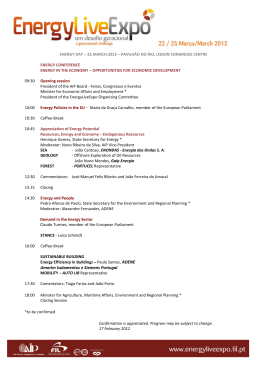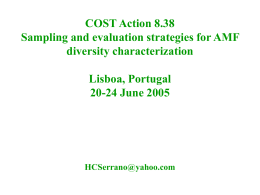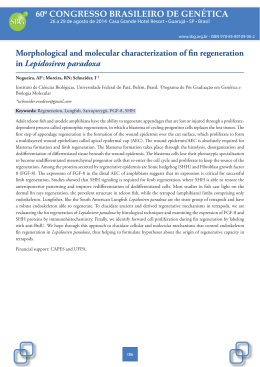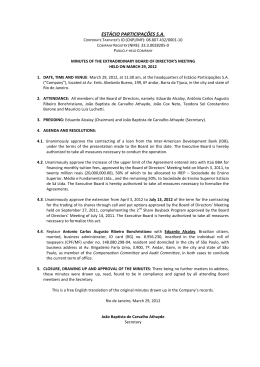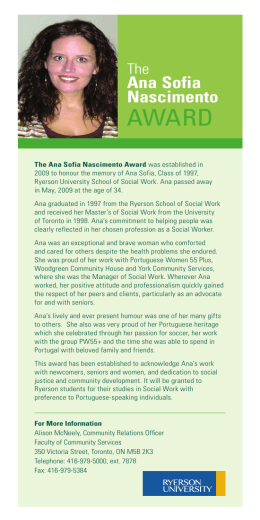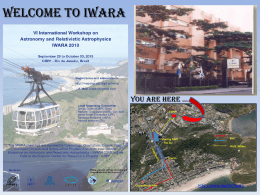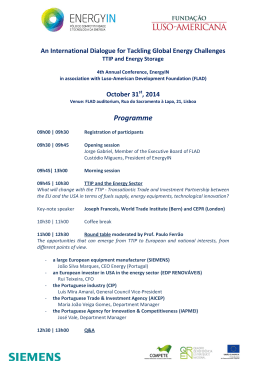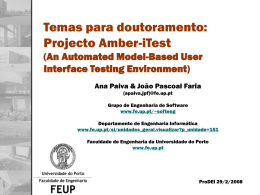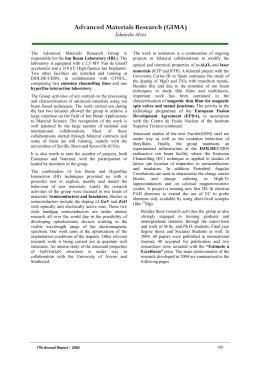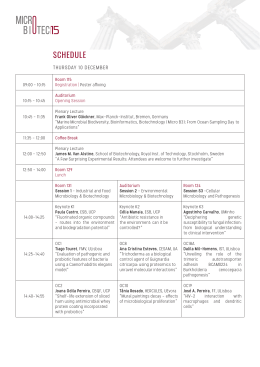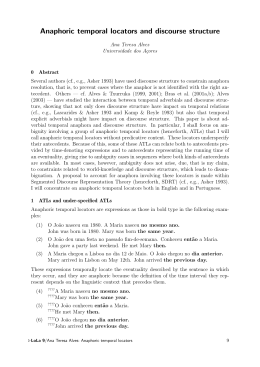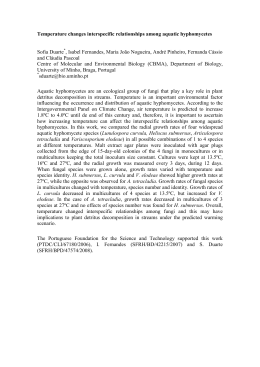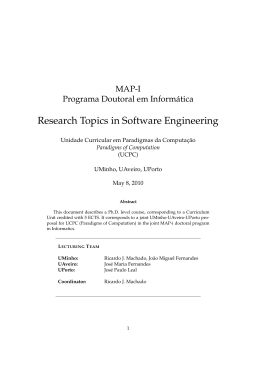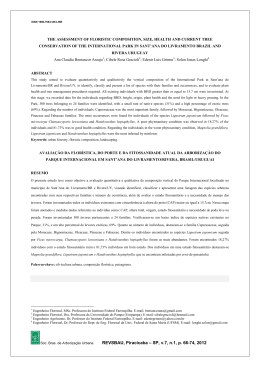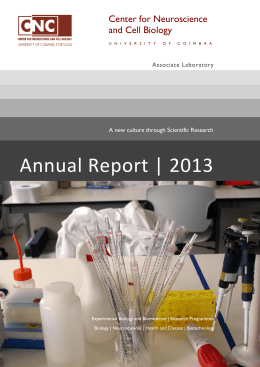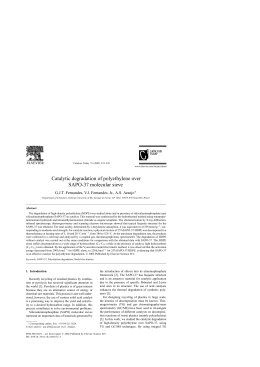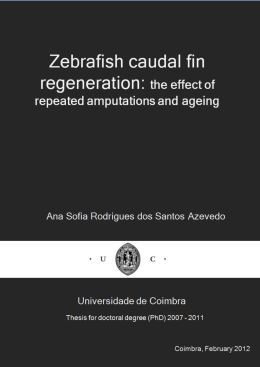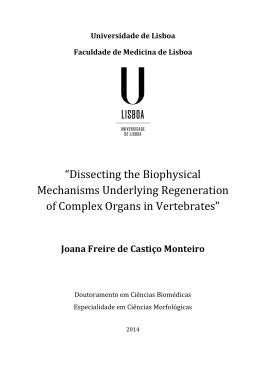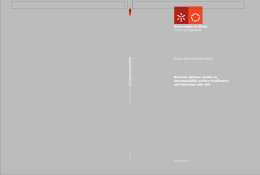Tissue Engineering at FCT/UNL Jorge Car valho Silva [email protected] GREAT - Grupo de Engenharia de Tecidos great.cefitec.df.fct.unl.pt Tissue Engineering Tissue Engineering is a branch of Biomedical Engineering that combines cells, materials and growth factors using the methods of engineering and the knowledge of the life and exact sciences for the development of biological substitutes to improve or replace the function of damaged or missing organs or tissues. 2 Tissue Engineering: Why? http://organdonor.gov/about/data.html 3 TO M O TO RR O DA Y W Tissue Engineering: the Future 4 Tissue Engineering: a multidisciplinary effort Materials Science Chemical Engineering Genomics Molecular Biology Cell Biology Clinicians Biochemistry Computational Biology Robotics 5 GREAT Grupo de Engenharia de Tecidos / Tissue Engineering Group Blood Vessels Skin Research subjects Bone Spinal Cord 6 Once upon a time... 3) * Nanofibre tube boosts nerve regeneration * Researchers at the National University of Singapore have used polymer nanofibre tubes to promote nerve regeneration. The tubes acted as guidance channels, enabling nerves to regrow in 45% of a test sample. See http://nanotechweb.org/articles/news/3/12/6 7 8 2007 Fibers electrospun for different needle tip-collector distances Fibers electrospun at different feed rates A systematic study of solution and processing parameters on nanofiber morphology using a new electrospinning apparatus, J. Nanosci. Nanotechnol.9, 3535-3545 (2009). Henriques, C; Vidinha, R.; Botequim, D.; Borges, J.P., Silva, J.C. 10 Nanofibres from chitosan-cellulose acetate blends for tissue engineering applications, Ricardo Vidinha, July 2008. 11 Chitosan nanofibre scaffolds for application as skin substitutes, David Botequim, December 2009 Influence of relative humidity on the electrospinning of the blend CS:PEO 1:1: 40%, 45%, 50% e 55%. Magnification: !5000. 12 Research subjects Tissue Engineering and Regenerative Medicine Application of the principles of biology and engineering to the development of functional substitutes for damaged tissue Deep burns are one of the most traumatic situations for the human body Skin Chronic, difficult to heal wounds are a major clinical problem Both substantially affect quality of life of patients No satisfactory and complete therapies pressure ulcer 3rd degree burn 13 Skin Biomimetic approach: Porous, flexible, multilayered structure Comprising both dermal and epidermal (i.e. full skin) equivalents Use of autologous cells (from the patient himself) Synergistic approach: Mix of natural and synthetic polymers Bioactive materials, wound healing accelerators Including anti-bacterial agents Skin2: a biosynthetic second skin, engineered to treat severe burn wounds PTDC/SAU-BMA/109886/2009 160 k! 14 Skin Development of biomimetic scaffolds as skin substitutes for the treatment of burns. Susana Gomes Electrospinning Collector Syringe Solution Needle Jet Syringe pump 3T voltage power supply High Taylor’s cone 15 Skin Development of biomimetic scaffolds as skin substitutes for the treatment of burns. Susana Gomes 16 Skin Estudo e optimização da técnica de Fiação Húmida para a produção de Microfibras de Quitosano. André Delgado, 2011 17 Skin Development of hybrid nano+micro fibrous matrices of chitosan for the treatment of extensive skin wounds Ana Espiga Machado 18 Skin Matrizes de Policaprolactona e Quitosano para aplicação em Engenharia de Tecidos. Valdir Tavares, 2011 19 Research subjects Tissue Engineering and Regenerative Medicine Application of the principles of biology and engineering to the development of functional substitutes for damaged tissue Blood Vessels Syringe needle High Voltage Power Supply Syringe needle High Voltage Power Supply Syringe pump Syringe pump Rotating and translating grounded collector 20 =0>?5)N!T&:NAU) SCV! "@>0A-)N!7#:24$') RR! RQ! %/BC/D-6>D-)N!!J) E>B9F-F/)N!W) XE! G56-HI5)N!Y"Z) VSSS! Construção e caracterização de um colector rotatório para a :9<B/6D5)F5) V[CE! produção 850/865D) N!&&) de nanofibras alinhadas Pedro Alexandre Marques Anacleto, 2008 ") L) #5'&!+'!&27$)*7;,2)!;,(27)!+#*!324$#*!,$)+-L2+#*!*'5-6+)!#!7)6325-$#./)!48!"K!VSSS!Y"Z!]! F&,:2#./)!QSS>^!LK!VSSS!Y"Z!]!F&,:2#./)!RSS>8! 21 -:(#+)*! 3)$#&! 4#*(#6('! *#(2*3#(;$2)*! #,'*#$! +#! #-*<672#! +)! ':=7($)+)! +'! 2#+#8!?&!':'@#+)!5$#-!+'!#:26A#&'6()!3)2!#:7#6.#+)!'!6/)!*'!@'$2327#&!324$#*! Research subjects 562327#(2@)*8!B>2*('&!#26+#C!7)&)!*'!,)+'!@'$2327#$!6#!325-$#!DE0F!#:5-&#*!324$#*! #&!7)&,:'()!'*(2$#&'6()8!9!+2%&'($)!+)!7):'7()$!,'$&2('!G-'!#*!324$#*!*'H#&! Tissue Engineering and Regenerative Medicine &#!(#>#!*-,'$2)$!+'@2+)!#)!#-&'6()!+#!I$'#!'!@':)72+#+'!+'!7):'7./)8!J)&!'*(#! ! *'&':A#6.#! +'! ()+#*! #*! ('*(#+#*C! )$2#! +#*! 324$#*! -&#!and +2$'7./)! Application of#!the principles of*'5-'! biology engineering to the )!'6(#6()C!,'$*2*('&!#:5-&#*!324$#*!*'&!G-#:G-'$!(2,)!+'!)$2'6(#./)!+'3262+#8!F! development of functional substitutes for damaged tissue !(-4)!+'!'*,-&#!,'$&2(2-!#,'6#*!#!#@'$25-#./)!+#!263:-<672#!+)!+2%&'($)!+)! -&#! @'L! G-'! 6/)! AI! 26('$'**'! 6)! 3#4$27)! +'! &'&4$#6#*! (-4-:#$'*! 7)&! '*(#*! ;+ Bone +,) 22 Bone P.Q. Franco et al. / Materials Letters 67 (2012) 233–236 235 Electrospun hydroxyapatite fibers from a simple sol–gel system Franco et al. / Materials Letters 67 (2012) 233–236 Patrícia Franco,P.Q.2009 235 23 Fig. 1. SEM images of the membranes a) 18-50 and b) 18-100, after sintering and respective diameters distribution. non-sintered sample presents the bands already mentioned for membranes produced from PVP solutions in ethanol/water mixtures are equal to the ones presented in Fig. 3. PVP presents the characPVP as well as the band at 3800 cm −1 resulting from the symmetric −1 corresponding teristic bands at 2950, 1656, 1459 and 1288 cm deformation of the hydroxyl groups present in HA. The first indica1. SEM images of the membranes 18-50 respectively and b) 18-100, after respective distribution. to C–H, Fig. C=O, C–H (cyclic groups) anda) C–N, [20].sintering The andtion of thediameters formation of an apatitic structure is a wide band at about 1000 cm −1 and 1100 cm −1. The bands at 960–965 cm −1 and at 560–601 cm −1 correspond to the symmetric stretching of the PO43− non-sintered sample presents the bands already mentioned for membranes produced from PVP solutions in ethanol/water mixtures ions. We can observe the presence of the main peak of the phosphate are equal to the ones presented in Fig. 3. PVP presents the characPVP as well as the band at 3800 cm −1 resulting from the symmetric group identified in the region in between 1100 cm−1 and 960 cm−1, teristic bands at 2950, 1656, 1459 and 1288 cm − 1 corresponding deformation of the hydroxyl groups present in HA. The first indicato C–H, C=O, C–H (cyclic groups) and C–N, respectively [20]. The tion of the formation of an apatitic structure is a wide band at about 1000 cm −1 and 1100 cm −1. The bands at 960–965 cm −1 and at 3PO 560–601 cm −1 correspond to the symmetric stretching of the PO43− 4 32PO4 CO ions. We can observe the presence of the main peak of the phosphate 3 group identified in the region inOH between 1100 cm−1 and 960 cm−1, OH Bone Production of three dimensional Poli(e-Caprolactone) and Hidroxiapatite porous scaffolds for bone regeneration Sara Ferreira, 2010 23 3- PO PO4 3 OH OH 18-100 As-spun 4 3- 2- CO 18-100 o Ts= 700 C CO OH 18-100 o Ts= 700 C 2- CO OH 3 PVP C-N C-H 18-100 As-spun C-H C=O PVP 3500 3000 2500 2000 1500 1000 500 Wavenumber / cm-1 C-N C-H Fig. 2. Diffractograms of the membrane 18-100, sintered at 500 °C, 600 °C and 700 °C. Fig. 3. FTIR spectra of a PVP film and of membrane 18-100 before and after sintering at 700 °C. C-H Hot pressing / porogen leaching 3500 C=O Fig. 2. Diffractograms of the membrane 18-100, sintered at 500 °C, 600 °C and 700 °C. 3000 2500 2000 1500 1000 500 Wavenumber / cm-1 SaOs2 - Osteoblasts Fig. 3. FTIR spectra of a PVP film and of membrane 18-100 before and after sintering at 700 °C. 24 Bone Production of composite chitosan/ hydroxyapatite microfibers using the wet-spinning method Liquid Crystalline Inverse Opals: New Bone like Assemblies for Tissue Engineering Carlos João, 2010 Carlos João, 2014 25 Research subjects Tissue Engineering and Regenerative Medicine Application of the principles of biology and engineering to the development of functional substitutes for damaged tissue Spinal Cord Development of biodegradable supports for the regeneration of neuronal tissue. Ana Luísa Marques, December 2011. 26 Número de células aderente/membrana Development of biodegradable supports for the regeneration of neuronal tissue. Ana Luísa Marques, December 2011. 60000 50000 CS alinhado 40000 30000 20000 CS desalinhado PCL alinhado 10000 0 com PDL/Lam sem PDL/Lam sem PDL/Lam CS alinhado Comprimento dos axónios / !m 0.120 0.100 0.080 CS alinhado Controlo CS desal. 0.060 0.040 0.020 0.000 Com Com PDL/Lam PDL/Lam Sem PDL/Lam 27 Wound dressings Development of a wound dressing based on nanofibers of polyvinilpirrolidone containing povidone-iodine. Andreia Fernandes. February, 2011. 28 Incorporação de nanopartículas de prata em matrizes de nanofibras de polivinilpirrolidona e avaliação do seu potencial antibacteriano. Rita Morais Rosa, Maio 2012 29 Biodegradable occlusive membranes for guided tissue regeneration or guided bone regeneration Composite membranes of poly(e-caprolactone)/ hydroxyapatite for dental applications João Martins, 2011 30 Biodegradable occlusive membranes for guided tissue regeneration or guided bone regeneration Chitosan/poly(e-caprolactone) membranes for dental applications Mafalda Fernandes, 2011 31 Entrepreneurial projects NovaTissue Assembly of 3D porous structures incorporating a pre-vascular network NanoSutures High-tech sewing 32 People – Staff and collaborators Members Célia Henriques, José Luís Ferreira Collaborators from FCT/UNL João Paulo Borges, Carmo Lança (Materials Science) Ilda Sanches, Alexandra Fernandes (Life Sciences) Pedro Coelho (Mechanical Engineering) Isabel Catarino, Grégoire Bonfait, Pedro Vieira (DF) 33 People – Staff and collaborators External Collaborators Maria Angélica Roberto Hospital “S. José”, Burns Intensive Care Unit & Plastic and Reconstructive Surgery, Director Manuela Mafra Hospital “S. José”, Anatomo-Pathology service Harshad Navsaria Barts and the London School of Medicine and Dentistry, Queen Mary, University of London Maria Gabriela Rodrigues, Gabriel Martins Faculty of Sciences, University of Lisbon Dora Brites, Adelaide Fernandes, Alexandra Brito, Ana Sofia Falcão Faculty of Farmacy, University of Lisbon Ana Isabel Silva Faculty of Engineering, Portuguese Catholic University Marise Almeida Faculty of Dentistry, University of Lisbon Sofia Prata Ceramed 34 MSc and PhD Students MSc Ricardo Vidinha, Pedro Anacleto, David Botequim, Patrícia Franco, Rita Maduro, Sara Ferreira, Carlos João, Andreia Fernandes, Ana Marques, João Martins, Mafalda Fernandes, Joana Fonseca, Valdir Tavares, Rita Carvalho, Rita Rosa; Cláudia Aragão, Ana Rosa, Sara Costa, Luís Martins, Joana Vasconcelos PhD Ana Espiga Machado, Susana Gomes, Carlos João, Ana Sofia Pedrosa 35 What Will Be the 10 Hottest Jobs? May 22, 2000 1 TISSUE ENGINEERS With man-made skin already on the market and artificial cartilage not far behind, 25 years from now scientists expect to be pulling a pancreas out of a Petri dish. Or trying, anyway. Researchers have successfully grown new intestines and bladders inside animals' abdominal cavities, and work has begun on building liver, heart and kidney tissue. 36 Tissue Engineering at FCT/UNL Jorge Car valho Silva Obrigado GREAT - Grupo de Engenharia de Tecidos CeFITec / DF / FCT / UNL
Download
